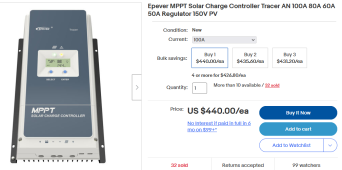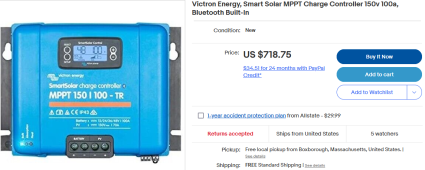SunnySoCal
New Member
- Joined
- Jan 8, 2022
- Messages
- 49
Here's what I've got:
Victron 100/50 SCC
Xantrex Freedom X 2000 W 12 volt (recent upgrade from 600 Xantrex PSW)
Hodge podge of panels all with very close Vmpp as configured (some 12 V in 2S and some 24 V) so array voltage ~36 V (Vmpp). Note that I bought panels with the Vmpp within a +/- 0.2 V range (as configured).
Recently added another 300 AH LiFePo4 (now have two of these) in parallel.
I only recently added the extra battery so that I could meet my design goal (again, also a new goal, after buying the 2000W inverter) of running my 7 cu ft freezer and a minifridge indefinitely if needed. Both have 11 A Locked Rotar Amp (LRA) compressors and why I bought the Xantrex (surge capabilities). The extra battery was to have 2-3 days of clouds/rain.
My dilemma is I think I've snookered myself as at 12 V I'm running 50/600 = 0.08 C charge rate. With my current ~36 V array the Victron limits at 50 Amps for hours around noon even this time of year. Will obviously be much worse outside of winter solstice
So, in hindsight, I should have bought a 24 Volt inverter. The Victron will run 24 V and thus I could double my power into batteries if I put them in series but now have 24 V battery which is not compatible with the inverter, obviously.
The other thing I liked about the Xantrex is it's adjustable LV disconnect.
What I'm thinking of doing is building a DC - DC (24V to 12V) high power converter. Yes, one can buy them but then I'd need to utilize another LV disconnect as they all seem to regulate the 12 V...something one would normally want...but this would defeat the inverter LV cutoff function.
I'm a retired EE and have breadboarded many circuits over my lifetime (and started at age 12 with a 3 tube shortwave radio kit). I'd like to build at least 100 Amp (at the 12 V), want it to track the nominal 24 voltage to maintain the inverter's LV cutoff function. I'm not as concerned about efficiency as the cost of panels seem to be nearly irrelevant wrt total system costs. I've got about 1000 W of panels but also have some shade issues, especially this time of year (high fence w/neighbor, and 5 palm trees clumped together to my south-west).
As another question, I've read lots of posts wrt best array voltage for MPPT. Seems like 2 - 2.5 times battery voltage is considered the sweet spot. If I stay at 12 V would running at ~ 54 V (reconfigure my series/parallel panel configuration) buy me anything?
Victron 100/50 SCC
Xantrex Freedom X 2000 W 12 volt (recent upgrade from 600 Xantrex PSW)
Hodge podge of panels all with very close Vmpp as configured (some 12 V in 2S and some 24 V) so array voltage ~36 V (Vmpp). Note that I bought panels with the Vmpp within a +/- 0.2 V range (as configured).
Recently added another 300 AH LiFePo4 (now have two of these) in parallel.
I only recently added the extra battery so that I could meet my design goal (again, also a new goal, after buying the 2000W inverter) of running my 7 cu ft freezer and a minifridge indefinitely if needed. Both have 11 A Locked Rotar Amp (LRA) compressors and why I bought the Xantrex (surge capabilities). The extra battery was to have 2-3 days of clouds/rain.
My dilemma is I think I've snookered myself as at 12 V I'm running 50/600 = 0.08 C charge rate. With my current ~36 V array the Victron limits at 50 Amps for hours around noon even this time of year. Will obviously be much worse outside of winter solstice
So, in hindsight, I should have bought a 24 Volt inverter. The Victron will run 24 V and thus I could double my power into batteries if I put them in series but now have 24 V battery which is not compatible with the inverter, obviously.
The other thing I liked about the Xantrex is it's adjustable LV disconnect.
What I'm thinking of doing is building a DC - DC (24V to 12V) high power converter. Yes, one can buy them but then I'd need to utilize another LV disconnect as they all seem to regulate the 12 V...something one would normally want...but this would defeat the inverter LV cutoff function.
I'm a retired EE and have breadboarded many circuits over my lifetime (and started at age 12 with a 3 tube shortwave radio kit). I'd like to build at least 100 Amp (at the 12 V), want it to track the nominal 24 voltage to maintain the inverter's LV cutoff function. I'm not as concerned about efficiency as the cost of panels seem to be nearly irrelevant wrt total system costs. I've got about 1000 W of panels but also have some shade issues, especially this time of year (high fence w/neighbor, and 5 palm trees clumped together to my south-west).
As another question, I've read lots of posts wrt best array voltage for MPPT. Seems like 2 - 2.5 times battery voltage is considered the sweet spot. If I stay at 12 V would running at ~ 54 V (reconfigure my series/parallel panel configuration) buy me anything?




